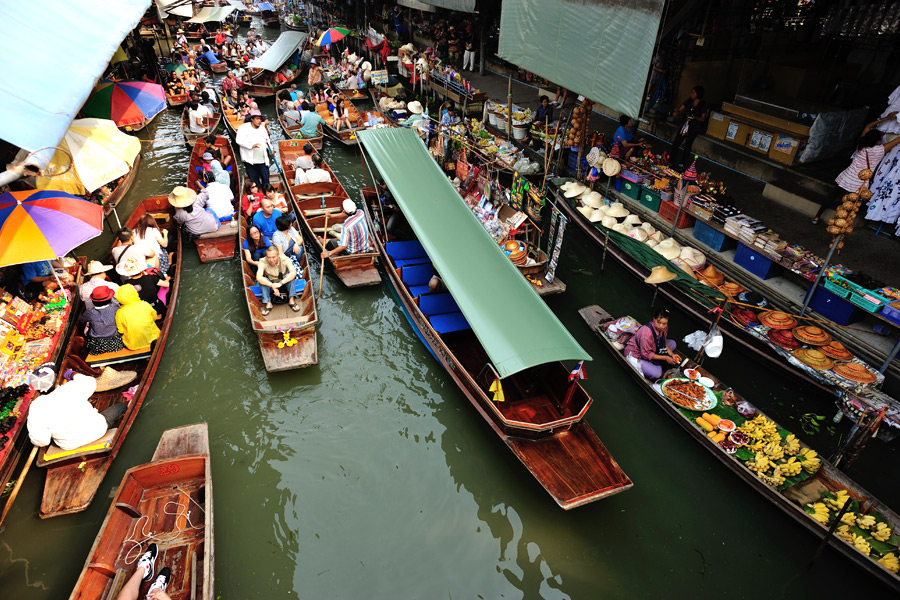[fshow photosetid=72157659628199140]
Thailand has a propensity for market places, the most famous perhaps the weekend market in Bangkok, affectionately referred to as JJ Market, or Chatuchak. Wet markets abound, and every little neighbourhood has its own market where people buy fruits, vegetables, clothes and accessories.
Northern Thailand is no different. In places like Chiang Mai, Chiang Rai, Phrae and Lampang, the market culture is alive and kicking. Here is a guide to the best markets to visit for a delightful northern experience.
Chiang Mai
Chiang Mai is an old trading port where people from all over the northern Thailand and Indochina have converged to conduct trade in natural resources and, of course, food. Even though the city has changed a lot in the last 30 years, it still remains a major centre for trade, which is evident in the city’s wet markets. The region enjoys a slightly cooler climate than the rest of Thailand, which means it is possible to grow a variety of fruit and vegetables and the markets reflect this.
Apart from offering an abundance of fresh produce, markets also provide a unique insight into the culinary make up of Thailand in general and northern Thailand in particular. While the west made the move towards supermarkets a long time ago, Thailand never went away from the fresh market and even big hotels and restaurants still send their staff to buy food at these markets.
Gat Luang is the largest market in Chiang Mai and the oldest one, located around Wichayanond Road. Meaning ‘The Great Market’, Gat Luang is made up of different sections, some for foods and dried foodstuff, some for household wares and souvenirs. The market was started in the 19th century by Chinese immigrants and grew during the 20th century when Chiang Mai grew as a major trading hub and many Chinese came to live in the city. Come early or in the evening for a large selection of fruits and finished foods.
Muang Mai market is another wholesale market in Chiang Mai popular with restaurants and hotels as well as private households. The market is open throughout the day and peak hours are between midnight and the early morning hours when most people are asleep but when farmers and suppliers bring in the harvest from the farms surrounding Chiang Mai. Muang Mai market is best for fresh fruit, vegetables, meat and fish. It is located along Ping River and Muang Samut Road.
Talat Pradu is popular for people who work in the centre of Chiang Mai. They come in the morning to pick up some breakfast on their way to work, or for a bite to eat in the evening when the area in front fills up with food stalls. There is a large section with ready-made food in large trays from where the seller scoops a portion onto a plate of rice for customers eating in, or bag it up in little see-through plastic bags for take away. The market is located on the inner side of the southern moat of the city wall and is open from early morning until around 8pm.
Chiang Rai
In Chiang Rai, don’t miss Talat Tetsaban, the municipality market, located one block north of the Clock Tower, on the corner of Suk Sathit and Uttarakit roads. Talat Tetsaban is the main market in Chiang Rai and the place to go for pretty much everything there is to buy in the town. The inside of the market is mostly for household things, clothes and fabrics, while the outermost part has fresh fruit and vegetables, meat, and finished dishes.
If visiting Chiang Rai during the weekend, don’t miss out on the Sunday walking market, held every Sunday in the inner city. You can buy everything from hill tribe artefacts, dried fruit, coffee, clothes, shoes and accessories and along the side streets are hundreds of food vendors. Starts around 5pm and finishes around 10 or 11pm.
Phrae and Lampang
There are also markets well worth a visit in Phrae and Lampang, which are both hidden northern gems with all the charm of Chiang Mai but none of the hustle and bustle.
The evening market in Phrae is popular with tourists and locals alike. There is a good combination of edible and non-edible items and even a bar where you can sit and have a drink while you watch people go by. The market is on very day, at Pradu Chai, between 5-10pm.
In Lampang, the place to go to really take in the charm of the city is the Friday market on Wangnua road north of the river. You can buy vintage kitchenware, decorative items, second-hand clothing, and food. The market is open from late afternoon until 10pm. There is also a weekend market along the main street, which has an eclectic combination of food, souvenirs and clothing.
Tips:
- Go to the markets in Thailand with an open mind. Hygiene standards are not what you might be used to at home but just remember that the vast majority of the food has been slaughtered, picked or felled the same day or the day before, something which cannot be said of the vacuum wrapped chicken breast or the bag of apples you find in the average western supermarket.
- Language may be a barrier, but you come a long way with a smile and body language. Simply point at what you want and the seller is often very likely to let you try before you buy.
- Always wash fruit and vegetables before you tuck in.

